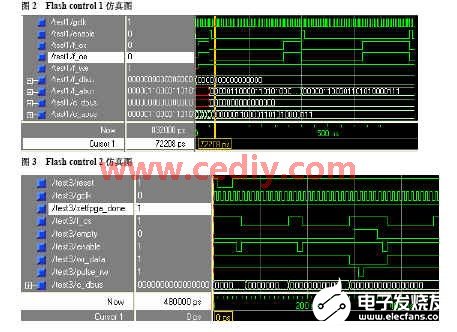

采用CPLD器件XC95288XL-7TQ144I芯片实现Flash读取控制设计
可编程逻辑
描述
1 概述
本设计已实用于国家863计划“可扩展到T比特的高性能IPv4/v6路由器基础平台及实验系统”项目中。其主要功能是对主控部分的FPGA读取Flash进行控制。
在本项目中,主控部分的FPGA在重启时需要从Flash中下载初始化程序。当下载完成后,FPGA仍会根据需要从Flash相应地址读取数据。这就要求在FPGA和Flash之间有一块控制逻辑来控制对Flash的读取。本设计就是完成的对这块控制逻辑的具体实现。
本文用VHDL语言在CPLD内部编程将其实现。本文第2节给出用VHDL语言在CPLD内部编程实现Flash读取的过程,第3节对全文进行概括总结。
2 实现
2.1 器件的选择
我们选用Xilinx公司XC9500XL 3.3V ISP 系列XC95288XL-7TQ144I芯片。XC95288xl是一个3.3V的低电压、高效的CPLD,在通信和计算机系统中的有广泛的应用。它包含16个54V18个功能块,提供了6400个可用的门电路,这些门电路的传播延时为6ns.
对于Flash,项目中选择了Intel公司的Intel StrataFlash系列的256-Mbit J3型Flash.其数据宽度可分别支持8位或者16位。
2.2 实现中的问题及解决方法
项目中选用的Flash的输出为16位,而向FPGA输出的数据为32位,因此产了数据宽度不匹配的问题,解决的方法有两种:
第一 使用两块相同的Flash,分别将其输出的数据送入FPGA接口的高16位和低16位;其缺点是需要增加一块Flash,从而成本增加。
第二 采用降低读取速度的方法,把从一块Flash中连续两次读取的16位数据拼接起来,组成一组32位的数据后送入FPGA接口。
出于对成本和复杂度的考虑,在此设计中我们采取了第二种方法加以实现。
2.3 基本设计模块图

2.4 用VHDL进行实现(注:实体部分定义可分别参见模块图中的划分)
Flash control 1
process(reset,gclk)
begin
if reset =‘0’ then
count_reset 《=‘0’;
elsif gclk‘event and gclk =’1‘ then
count_reset 《= not(count(4) and count(3) and count(2));
end if;
end process;
process(count_reset,gclk)
begin
if count_reset =’0‘ then
count 《=(others =》’0‘);
elsif gclk’event and gclk =‘1’ then
count 《=count +1;
end if;
end process;
process(count_reset,reset,enable)
begin
if reset =‘0’ then
F_CS 《=‘1’;
F_OE 《=‘1’;
F_WE 《=‘1’;
elsif count_reset =‘0’ then
F_CS 《= ‘1’;
F_OE 《= ‘1’;
F_WE 《= ‘1’;
elsif enable‘event and enable =’1‘ then
F_Abus 《= C_Abus;
F_CS 《= ’0‘;
F_OE 《= ’0‘;
F_WE 《= ’1‘;
C_Dbus 《= F_Dbus;
end if;
end process;
Flash control 2
d_count_rst 《= not(d_count(1) and (not d_count(0)) and empty);
sig_WD 《= not(d_count(1) and (not d_count(0)));
WR_DATA 《= sig_WD;
process(gclk,d_count)
begin
if reset =’0‘ then
d_count 《= ’1‘;
elsif F_CS = ’1‘ then
d_count1 《= not d_count1 ;
if gclk’event and gclk =‘1’ then
d_count2 《= d_count1;
d_count 《= d_count2;
end if;
end if;
end process;
process(reset,d_count,C_Dbus)
begin
if reset = ‘0’ then
data_adder 《= (others =》‘0’);
elsif d_count‘event and d_count = ’0‘ then
data_adder(31 downto 16) 《= C_Dbus;
elsif d_count’event and d_count = ‘1’ then
data_adder(15 downto 0) 《= C_Dbus;
end if;
end process;
enable 《= enable1 and enable2;
process(reset,d_count,F_CS)
begin
if reset = ‘0’ or F_CS = ‘0’ then
enable1 《= ‘1’;
enable2 《= ‘1’;
elsif d_count‘event then
if gclk’event and gclk =‘1’ then
enable1 《= ‘0’;
enable2 《= not enable1;
end if;
end if;
end process;
process(reset,F_CS)
begin
if reset = ‘0’ then
address《= X“400000”;
elsif F_CS = ‘1’ then
C_Abus 《= address;
address 《= adderss +1;
end if;
end process;
process(reset,F_CS)
begin
if reset = ‘0’ then
address《= X“400000”;
data_adder 《=(others =》‘0’);
elsif F_CS = ‘1’;
address 《= adderss +1;
end if;
end process;
process(d_count2,F_CS)
begin
if F_CS = ‘0’ then
enable1 《= ‘1’;
enable 《= ‘1’;
elsif d_count2 = “00” or d_count2 = “01” then
enable 《= ‘0’;
end if;
end process;
process(gclk,sig_WD)
begin
if sig_WD = ‘1’ then
Pulse_RW 《=‘1’;
elsif gclk‘event and gclk =’1‘ then
W_D1 《= sig_WD;
W_D2 《= W_D1;
if empty =’0‘ then
data_adder1 《= data_adder;
Pulse_RW 《= (W_D1 or (not W_D2));
end if;
end if;
end process;
(注:此程序在Xilinx公司的ISE6.2i环境下用VHDL编程实现,其仿真波形见下图)

3 结束语
在实际应用中,以此CPLD对Flash的读取进行控制。仿真结果及最后的实际调试都表明该设计符合项目的要求。在程序中通过对读取的记数控制,本设计可以在不增加Flash片数的情况下支持16/32/64位的数据输出宽度。可以节约一定的成本,具有相当的灵活性和实用性。
责任编辑:gt
-
FPGA芯片-XC3S50A-5TQ144C可由其他什么芯片代替?2012-04-07 2282
-
CPLD控制读取外部配置flash的问题2013-07-31 3923
-
XC95288XL程序怎么下载2019-03-08 2674
-
是否有XC95144XL CPLD的评估板2019-04-26 2306
-
XC9500XL系列CPLD上执行的辐射研究?2019-04-30 972
-
请问有xc3s200-tq144配置图吗?2019-05-16 2141
-
请问哪位有周立功 DP-51+单片机开发板上CPLD(U7/XC9572XL-TQ100)的源码或者编程原理?2019-06-04 3024
-
如何编程CPLD xc9500xl?2019-10-21 3266
-
CPLD XC95288身份错误2020-04-07 2777
-
如何使用ISE 14.4编程XC95288XL?2020-04-24 1918
-
基于CPLD的Flash读取控制的设计与实现2009-09-04 514
-
采用XC95144XL芯片模块实现VGA视频显示系统的设计2019-08-01 9985
-
XC95144XL高性能CPLD各引脚功能的详细资料免费下载2019-10-16 2886
全部0条评论

快来发表一下你的评论吧 !

